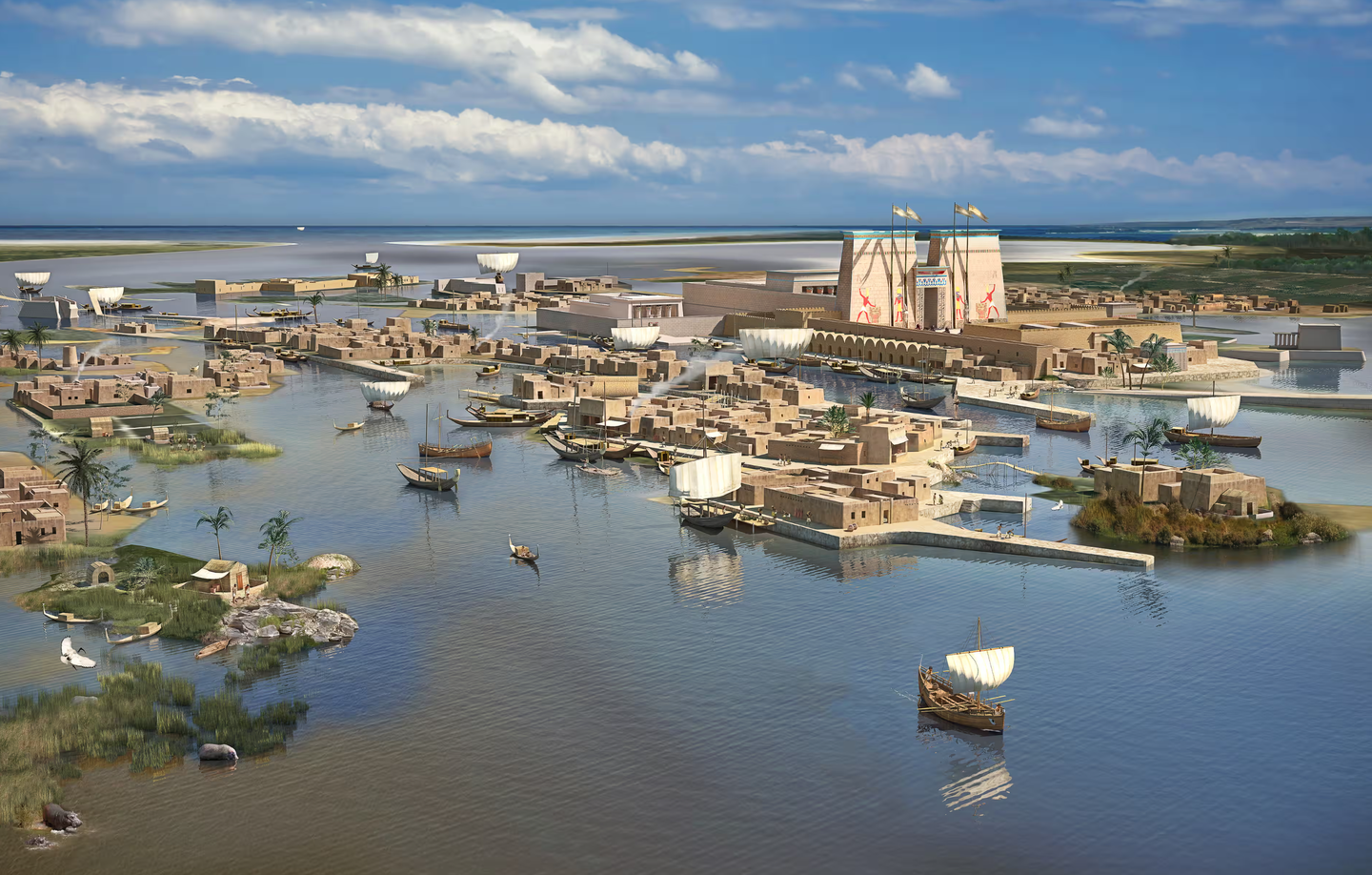2,500-year-old lost city of Thonis-Heracleion discovered in Egypt
Thonis-Heracleion once thrived at the mouth of the Nile, a vibrant city pulsing with trade and ceremony.

A recreation of what Thonis-Heracleion may have looked like. (CREDIT: Yann Bernard / Franck Goddio / Hilti Foundation)
Thonis-Heracleion once thrived at the mouth of the Nile, a vibrant city pulsing with trade and ceremony long before Alexandria rose to power in 331 BCE. It stood as Egypt’s main gateway to the Mediterranean, where goods, people, and cultures mingled. At its heart, a grand temple dedicated to Amun played a vital role in dynastic rituals, blending myth and reality in the rhythm of everyday life.
Founded around the 8th century BCE, the city prospered through centuries of natural disasters and political change. Yet by the 8th century AD, it had disappeared beneath the waves. Historians like Herodotus kept its memory alive, describing the temple where the Greek hero Herakles was said to have first touched Egyptian soil.
Strabo, another ancient geographer, placed the city at the Canopic mouth of the Nile. Still, for centuries, Thonis-Heracleion remained little more than a legend. No visible trace of its temples, ships, or canals surfaced, leaving scholars to wonder if it had ever truly existed at all.
Everything changed in 2000 when Franck Goddio and his team at the European Institute for Underwater Archaeology (IEASM) made a historic discovery. After years of searching, starting in 1996, they finally found Thonis-Heracleion six kilometers off Egypt’s coast, submerged beneath ten meters of water in Aboukir Bay.
The find not only revived a lost chapter of ancient history but also solved a long-standing mystery—Thonis and Heracleion were not two cities, but one. The Egyptians and Greeks had simply known it by different names. What Goddio’s team revealed was an entire world, sealed under silt and sea for more than a thousand years.
Among the remarkable finds were colossal statues, temple ruins, and daily life artifacts such as coins and ceramics. Together, they told the story of a city that flourished between the 6th and 4th centuries BCE, when its massive harbors turned it into a bustling hub of Mediterranean trade.
Related Stories
Archaeologists uncovered over 700 anchors and 79 shipwrecks, proof of the city’s vibrant maritime activity. A network of canals wound through its layout, creating a watery maze of homes, temples, and marketplaces scattered across a web of islands—an echo of a civilization once alive with the sounds of commerce and ceremony.
Thonis-Heracleion also served as a religious center, where the Mysteries of Osiris were celebrated annually, symbolizing the god’s rebirth. Ceremonies took place along the canals, with Osiris being carried in a ceremonial boat from the temple of Amun-Gereb to his shrine in Canopus. These rituals were central to the religious and cultural identity of the city.
One of the more recent and significant discoveries came in 2021 when an Egyptian-French underwater team uncovered the remains of a military vessel beneath the ancient city. The ship, built in the classical tradition with Egyptian shipbuilding techniques, sank in the 2nd century BCE while loading massive stones from the temple of Amun.
This ship, around 25 meters long, was a rowing vessel equipped with a large sail. Its flat bottom and keel made it ideal for navigating the Nile and the surrounding Delta.
Ayman Ashmawy from the Egyptian Ministry of Antiquities described the discovery as a rare find, noting that only a handful of such ships from this period have ever been recovered. The ship, buried under five meters of clay and temple debris, was preserved by the very blocks it had been transporting, which settled over the wreck during a cataclysmic event.
Further excavations revealed a large funerary complex that likely belonged to Greek merchants who had settled in Thonis-Heracleion during the late Pharaonic dynasties.
These merchants, who had constructed their own sanctuaries near the grand Egyptian temple, were integral to the city's economy, controlling access to Egypt at the Canopic branch of the Nile. Their presence underscores the multicultural nature of the city, where Egyptians and Greeks lived side by side, sharing religious and commercial spaces.
Thonis-Heracleion’s story does not end with these discoveries. Archaeologists believe that only 5% of the city has been excavated so far, leaving much of its history still submerged beneath the sea. Mostafa Waziri, Secretary-General of the Supreme Council of Antiquities, emphasized the significance of these finds, noting that the city was once Egypt’s largest port before Alexandria was established.
The city’s downfall came through a series of earthquakes and tidal waves that liquefied the land, causing it and the neighboring city of Canopus to sink. Rediscovered in 1999 and 2001, respectively, these two cities continue to provide invaluable insights into ancient Egyptian and Greek interactions.
The underwater exploration of Thonis-Heracleion is far from over. As technology advances, new methods will likely reveal more of the city’s secrets. Franck Goddio believes the city still holds untold treasures, waiting to be unearthed.
The importance of these findings stretches beyond just understanding Thonis-Heracleion; it illuminates a vital chapter in the history of Mediterranean trade and cultural exchange. The city, once lost beneath the sea, now tells its story through the artifacts and ruins brought to the surface.
Note: Materials provided above by The Brighter Side of News. Content may be edited for style and length.
Like these kind of feel good stories? Get The Brighter Side of News' newsletter.
Rebecca Shavit
Science & Technology Journalist | Innovation Storyteller
Based in Los Angeles, Rebecca Shavit is a dedicated science and technology journalist who writes for The Brighter Side of News, an online publication committed to highlighting positive and transformative stories from around the world. With a passion for uncovering groundbreaking discoveries and innovations, she brings to light the scientific advancements shaping a better future. Her reporting spans a wide range of topics, from cutting-edge medical breakthroughs and artificial intelligence to green technology and space exploration. With a keen ability to translate complex concepts into engaging and accessible stories, she makes science and innovation relatable to a broad audience.



